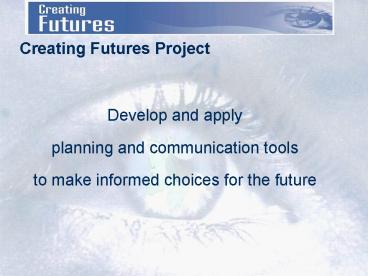Creating Futures Project - PowerPoint PPT Presentation
1 / 21
Title:
Creating Futures Project
Description:
Govt funded - Foundation of Research, Science & Technology ... Hydrology. NIWA. Draft SDSS. System Design. Region. District. Local. GEONAMICA - RIKS ... – PowerPoint PPT presentation
Number of Views:54
Avg rating:3.0/5.0
Title: Creating Futures Project
1
Creating Futures Project
- Develop and apply
- planning and communication tools
- to make informed choices for the future
2
Creating Futures
- Govt funded - Foundation of Research, Science
Technology - 1.6Million - Four Year Project (2006 to 2010)
- Environment Waikato - Lead Agency
- Several Research Partners
3
Creating Futures
Developing and applyingplanning tools to make
informed choices for the future
Dr Liz Wedderburn OBJECTIVE 1 Improved
communication deliberation tools,
Dr Daniel Rutledge OBJECTIVE 2 Spatial decision
support system development
Scenarios
4
Objective 1Processes to evaluate, deliberate,
and choose futures through scenario analysis and
multi-criteria evaluation frameworks
- Create scenarios based on trends and activities
- Diagnose stakeholder interests and specify issues
from scenarios - Analyse underlying system and identify indicators
- Evaluate different scenarios based identified
issues indicators - Deliberate on information identified through
evaluation - Revisit assumptions, indicators issues as
deliberation suggests
5
DeliberationMatrix
Strategies / Scenarios
Stakeholders
Values / Indicators
6
Objective 2Development of Spatial Decision
Support Systems to support long-term, integrated
planning
- Why an SDSS?
- Long-term integrated planning and resource
management are examples of wicked or
unstructured problems - Characterised by
- Multiple actors
- Multiple values views
- Multiple outcomes possible
- High uncertainty
After van Delden 2000
- An SDSS helps address unstructured problems
- Integrates society, economy, and environment
(systems approach) - Identifies links feedbacks
- Sets limits explicitly (e.g., only so much land,
water, soil) - Demonstrate importance of where in addition to
what and how much
7
Example of Unstructured ProblemWaikato Region
Community Outcomes
- Sustainable Environment - The Waikato region
values and protects its diverse, interconnected
natural environments. - Quality of Life - The Waikato region is a great
place to live, providing the services and
opportunities we need to live well. - Sustainable Economy - The Waikato region balances
a thriving economy with looking after its people,
places and environment. - Culture Identify - The Waikato region
identifies with - and values - its land, air
rivers and waterways, mountains, flora, fauna and
its people. - Participation Equity - The Waikato region
builds strong informed communities and has a
culture that encourages people and communities to
play their part.
8
Waikato 2006
- Population 387,700(StatsNZ June 06 est.)
- Households 145,100(StatsNZ June 06 est.)
- Land Cover (LCDB 2)
- Agriculture 55.2
- Natural 28.2
- Forestry 14.4
- Urban 1.1
- Other 1.0
- GDP 12 Billion(2003 GDP 3 annual growth)
- Ecological Footprint 9 ha
- Businesses 34,000
9
Waikato 2026?
- Population 426,800(39,100, StatsNZ 2026 med.
est.) - Households 169,400(24,300 StatsNZ June 06
est.) - Land Cover (LCDB 7)
- Agriculture ?
- Natural ?
- Forestry ?
- Urban ?
- Other ?
- GDP 33 Billion(2003 GDP 3 annual growth)
- Ecological Footprint ?
- Businesses 50,000 ?
?
10
SDSS Systems Approach
Society
Economy
Environment
Systems models track stocks flows over time
11
Goods
Society
Economy
Labour
Wastes
Environment
Resources
12
SDSS Operates at 3 Scales
Local (200 x 200 m cells)
Region
District
13
Draft SDSS System Design
14
WRDEEM Waikato Region DynamicEconomy-Environment
Model
- From ARDEEM - Auckland-based model developed
under the Pathways to SustainabilityFRST
Programme - Models flows of economic commodities
- monetary (NZ1998)
- physical (tonnes)
- natural resource inputs (e.g. land, energy,
water) - residual outputs (e.g. wastes, pollutants and
emissions). - Simulate combined environmental and economic
implications of change between 1998 and 2051.1 - Driven by economic growth scenarios
Labour Force Module
Growth Module
Economic Module
Economic Physical Flow Module
Environment- Economy Physical Flow Module
15
Waikato SDSS Prototype
- Developmentco-funded by Landcare Research
- RIKS METRONAMICA model populated with Waikato
data - Only models land use change
- Demand for land use set explicitly
16
3 Mock Scenarios for Waikatos Future2001-2050
based on SDSS Prototype
Dairy Expansion
Land for dairying increases 4 annually
17
3 Mock Scenarios for Waikatos Future2001-2050
based on SDSS Prototype
Diversification
Demand for non-dairy primary production land
increases
18
3 Mock Scenarios for Waikatos Future2001-2050
based on SDSS Prototype
Village Life
Residential land increases 7-fold
19
3 Mock Scenarios for Waikatos Future2001-2050
based on SDSS Prototype
Dairy Expansion
Diversification
Village Life
Residential land increases 7-fold
Demand for non-dairy primaryproduction land
increases
Land for dairying increases 4 annually
20
What We Want to Achieve
- Planning tools that inform communities
- Tools expose links and trade-offs
- Councils use these tools
21
Contacts
- Dr Beat Huser, Environment Waikato
- Project Leader
- Beat.Huser_at_ew.govt.nz
- Dr Daniel Rutledge, Landcare Research
- Science Leader Objective 2 Leader
- rutledged_at_landcareresearch.co.nz
- Dr Liz Wedderburn, AgResearch
- Objective 1 Leader
- liz.wedderburn_at_agresearch.co.nz































